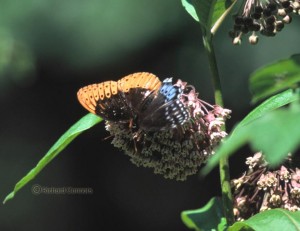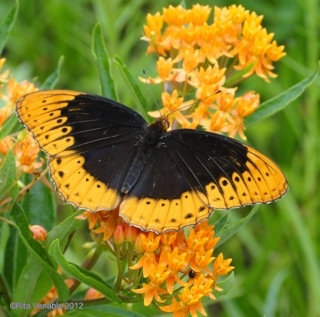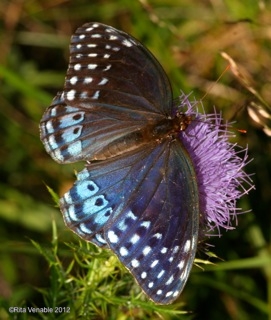Of all the butterflies that live in Tennessee, Diana Fritillaries are ones that people would travel from far and wide to see. Tis the season to see them in Tennessee.
Colorful and large with a 3.7″ wingspan, Diana Fritillaries look like they carry smaller, darker butterflies on their wings. Both males and females have rounded wings and lack the silvery spots below that other fritillaries have. Females are dark bluish black while males are orange with dark chocolate centers. Males are redheads.
Dianas live in moist, shady forests with rich, deep soil where violets grow. In Tennessee, they generally live on the Cumberland Plateau and eastward. Diana caterpillars feed only on violets. Adults, however, need flowers to nectar on, and the fields, meadows, roads, trails, and flower gardens near these forests are important nectaring spots. These two essential areas may be far apart, but adults must be able to reach both so they can both feed and reproduce.
Diana nectaring preferences vary regionally, but in Tennessee, adult Diana Fritillaries like milkweeds—orange, common, and white in particular. They also have been documented nectaring on thistle, red clover, bee balm, purple coneflower, blazing star, and ironweed in Tennessee. Dianas like to nectar during the cool of the day—in the morning and late afternoon. They fly to the woods when the temperatures get hot in the middle of the day.
According to NatureServe, a non-profit conservation organization, the Diana Fritillary is presently secure for now, although there has been widespread loss of populations and there are several threats to their long-term survival. Strip mining clears the land of forest and the understory of violets. Clear-cutting is a mixed bag—if the area cleared is too large it can eliminate breeding habitat for decades. If the clear-cut areas are small, or only selected trees are harvested, then violets and nectaring plants might increase as long as the surrounding forest and understory is left intact. Fortunately, Dianas may return (recolonize) as the forest grows back.
Of course, large-scale pesticide and herbicide spraying are detrimental to both butterflies and the plants they depend upon for survival. Residential developments in the Appalachians are one of the biggest threats to Dianas. Even if trees are preserved, lawns often replace violets. On the other hand, cultivated flower gardens may increase the food supply for adult Dianas. Deer, excessive roadside mowing, and invasive plants can destroy hostplants or nectaring plants.
So, go out and see them while you can. Males and females fly only one or two months together, romancing and nectaring even in the misty rain of a summer day.
©Rita Venable 2013

For more photogrpahs, check Richard Connor’s pbase photo website at:

